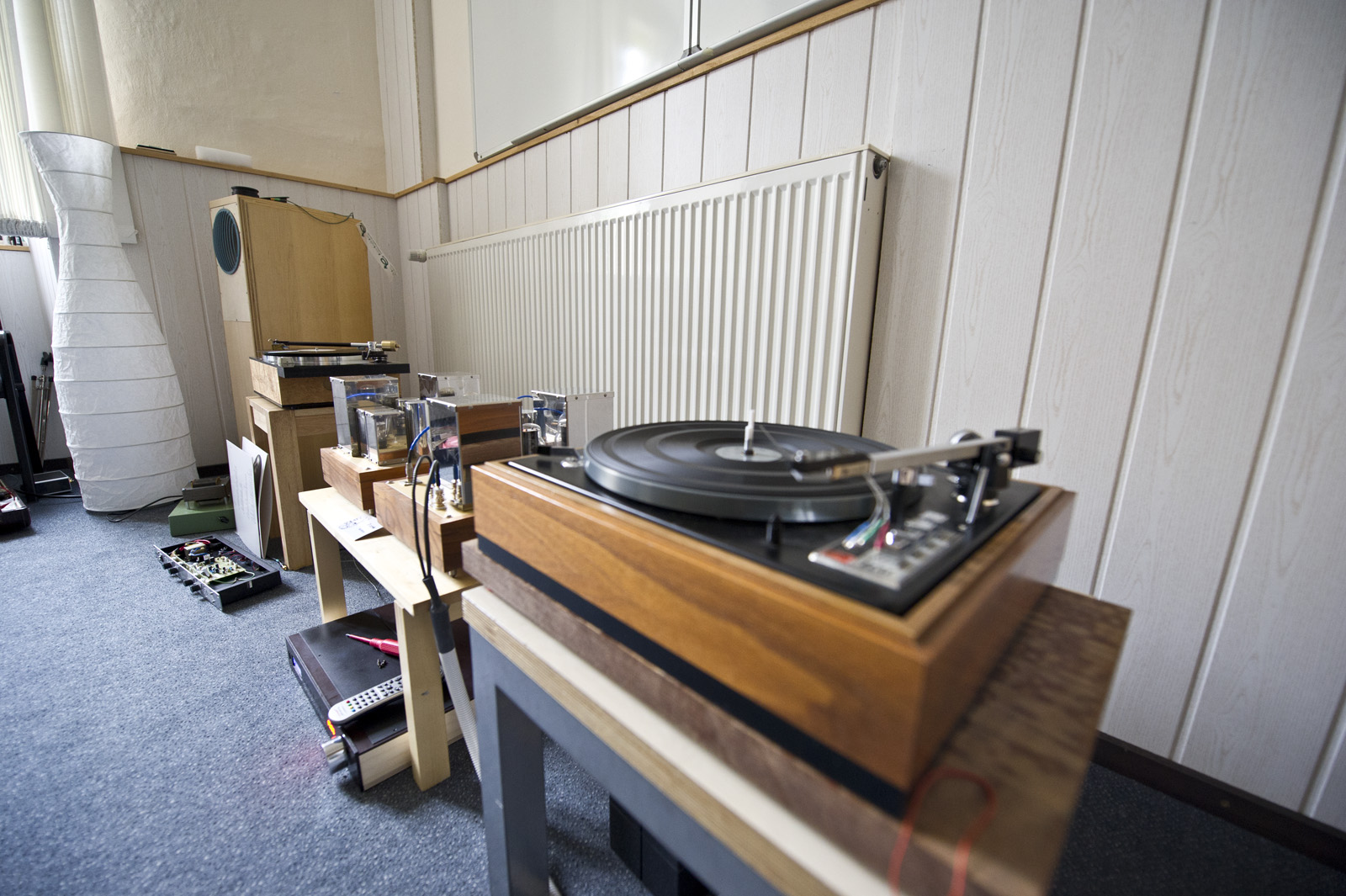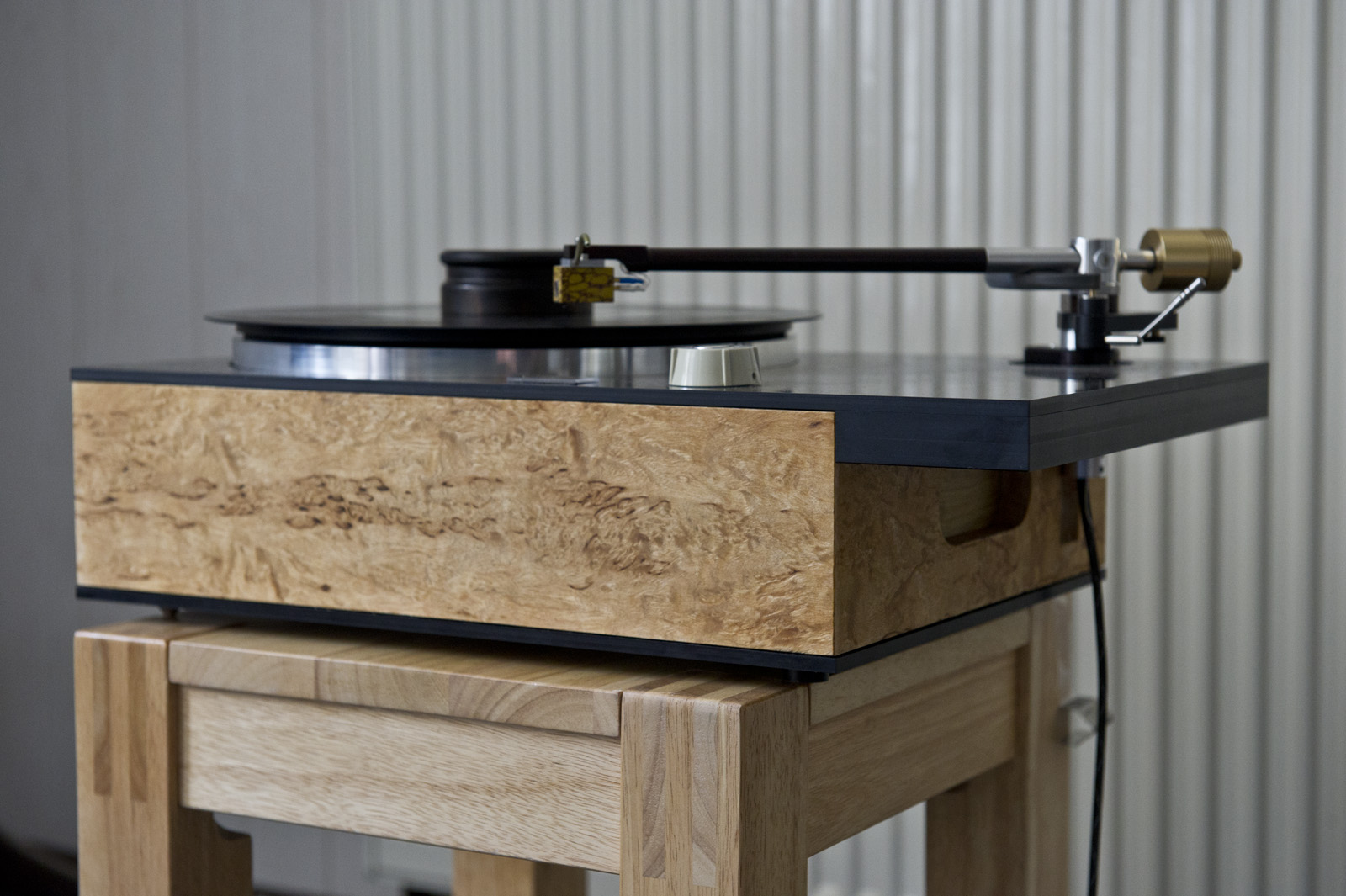Witch is a very bad practice, as the vinyl vibrations are not damped by the platter cover.Nope, same length. It's just a VERY small turntable ;-) Doesn't even have a full size platter(I'm not kidding).
Dear Christophe,
I must assume you have heard the turntable in question to be able to support your statement. Sorry to have missed you at the Munich show.
The first 6-8mm(depending upon the record mat used) of the modulated area are not in touch with the mat. I know many people who use mats like the ring mat or "dot"-mats(not my preference either, but still...), claiming that they prefer the results they are getting.
In reality, many records do not make full surface contact due to warps or being dished. I used a (moderately heavy)record weight and did not get any comments about the sound of the first few minutes being inferior to the rest of the record. Often the "lip" of post pancake era records prevents an intimate contact with "full size" or even larger record platters or mats.
I can also substitute the 276mm platter with a "full size" (300mm) platter(or a rigid mat like the Goldmund mat) and, guess what, the smaller platter yields superior results. Mmmhh..... so to take advantage of a full area record to mat interface(theoretically preferable off course), major design changes would have to be implemented(motor and drive system). That was never the goal. I just wanted to show that you can build a world class turntable based on a well tought out design from the early 60ies that is NOT the size of your average gravestone.
And I invite anyone to bring their full size platter deck and compare it to this inadequate little "toy"
It will be an eyeopener...
Lastly, here is a link to a deck(based on an Elac Miracord 50H) with magnetically suspended platter(~ 50gr. load on the trust area remaining) and a pivoted arm(just a modification of the original) with zero tracing error that I built for this years Frickelfest.
http://www.holgerbarske.com/wp-content/uploads/2012/06/ff12_fsps556.jpg
Easy to implement on many a deck that started life as a record changer... and it can be done in less than two days.
À bientôt,
Frank
I must assume you have heard the turntable in question to be able to support your statement. Sorry to have missed you at the Munich show.
The first 6-8mm(depending upon the record mat used) of the modulated area are not in touch with the mat. I know many people who use mats like the ring mat or "dot"-mats(not my preference either, but still...), claiming that they prefer the results they are getting.
In reality, many records do not make full surface contact due to warps or being dished. I used a (moderately heavy)record weight and did not get any comments about the sound of the first few minutes being inferior to the rest of the record. Often the "lip" of post pancake era records prevents an intimate contact with "full size" or even larger record platters or mats.
I can also substitute the 276mm platter with a "full size" (300mm) platter(or a rigid mat like the Goldmund mat) and, guess what, the smaller platter yields superior results. Mmmhh..... so to take advantage of a full area record to mat interface(theoretically preferable off course), major design changes would have to be implemented(motor and drive system). That was never the goal. I just wanted to show that you can build a world class turntable based on a well tought out design from the early 60ies that is NOT the size of your average gravestone.
And I invite anyone to bring their full size platter deck and compare it to this inadequate little "toy"
It will be an eyeopener...
Lastly, here is a link to a deck(based on an Elac Miracord 50H) with magnetically suspended platter(~ 50gr. load on the trust area remaining) and a pivoted arm(just a modification of the original) with zero tracing error that I built for this years Frickelfest.
http://www.holgerbarske.com/wp-content/uploads/2012/06/ff12_fsps556.jpg
Easy to implement on many a deck that started life as a record changer... and it can be done in less than two days.
À bientôt,
Frank
Last edited:
a pivoted arm(just a modification of the original) with zero tracing error that I built for this year's Frickelfest. Easy to implement on many a deck that started life as a record changer... and it can be done in less than two days.
Thank you for showing the interesting arm. I think that's the most doable arm for DIYers. I have thought about such designs before but simply cannot think of a way to deal with the vertical movement that can affect the tangency. I guess when you have a warp record you will have mistracking regardless of design. Is there's any picture showing how the spindle is implemented? I have to assume the spindle is one of the fixed corners of the Thales circle. When the headshell goes up and down which creates a vertical arc and how can you deal with the spindle side when it's a vertical straight line as guidance? Do you just let it simply mistrack on those warping occasions? Instead of a single light mass straight tube as guiding rod, I thought using a fork-like two-rod guiding mechanism sliding pass the tall spindle. Downside is that it adds more mass...
I have a salvaged arm from a Kenwood KD-770D turntable that has a removable headshell and the armwand is straight which will be a great candidate for this experiment and it's reversible. The Graham Robin is also another good candidate.
Thanks again for your kind contribution to this thread. I really like keeping the spirit of playfulness in this thread, as some people are just so serious about everything. Keep the fun coming!
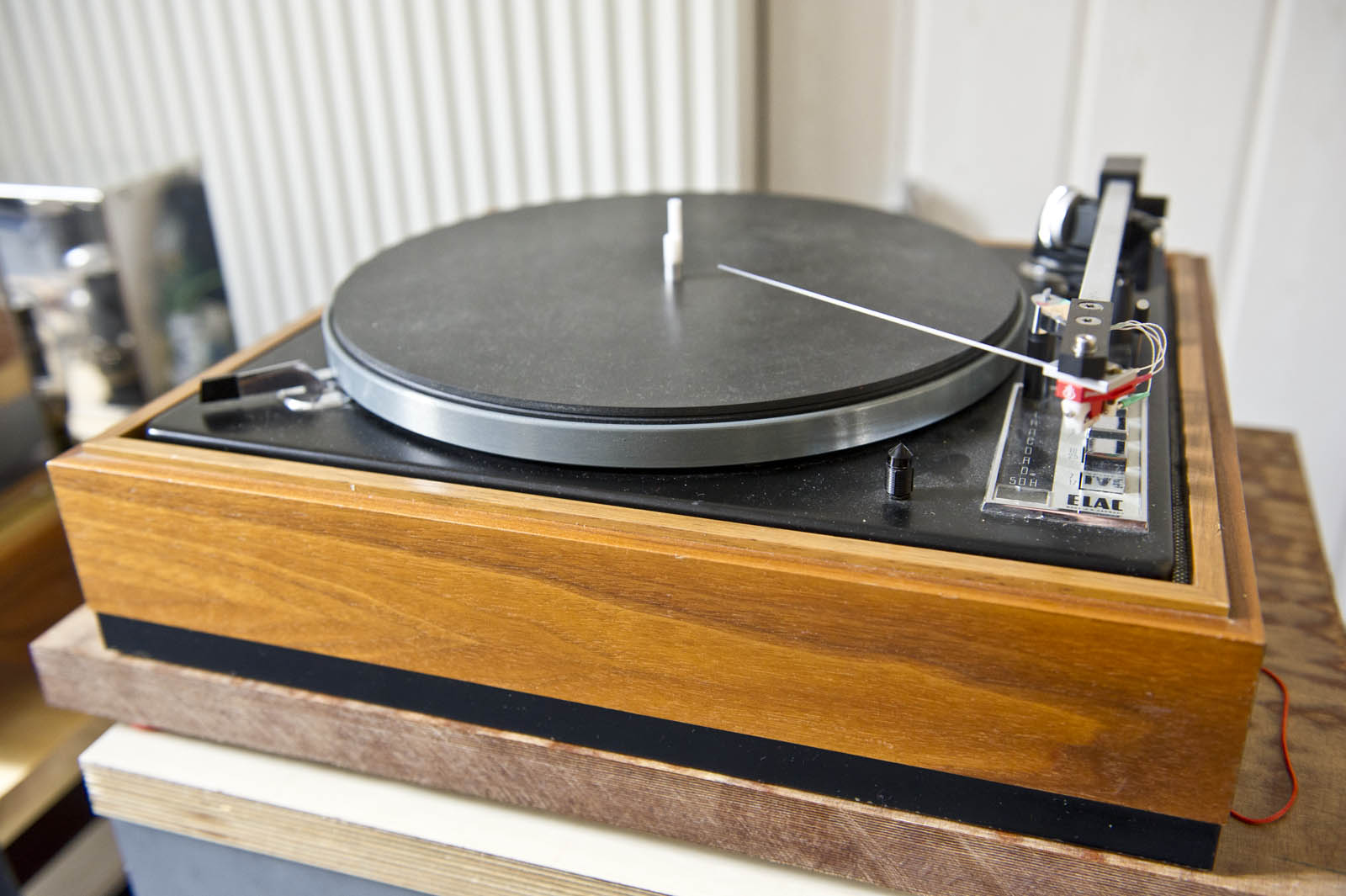
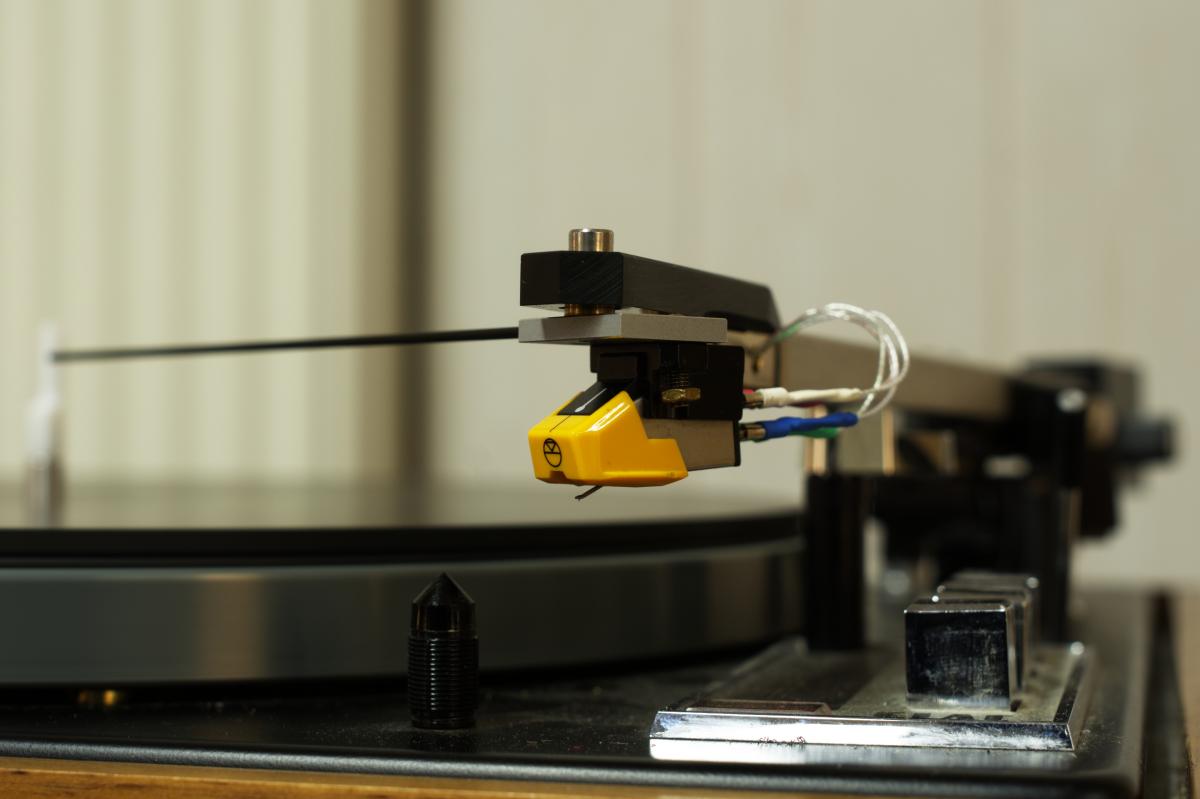
Last edited:
Okay, from the higher rez picture, I think I know how it's done. The spindle is an adaptor over the existing spindle space with top portion being a half diameter cylindrical piece and the skating force will keep the rod touching the spindle constantly. (How do you set anti-skating?) And the contact point is the dead center of the spindle. Clever!!
Frank, you're a genius!
Frank, you're a genius!
Hi again,
The white center spindle is stationary and, since it's made out of Teflon(no stiction!) will only add (minimal)friction to the lateral movement. It can be seen as a damping device(working in both planes).
The headshell-plate can rotate, thanks to two ball bearings in the black, upper headshell section. The wiring can be bent to act as a spring so the headshell-plate and the carbon fibre tube(mass: 0,3gr!) that is attached to it at a 90° angle "leans" against the Teflon spindle. The slight pressure required can be generated by other means as well, but I wanted to keep it as simple as possible.
I actually should have left the Teflon piece at its 7,15mm diameter and should have mounted the thin CF tube a little forward of the stylus plane. Would work just fine and omits the need to turn the smallish Teflon piece excentrically(somewhat tricky to do, since Teflon "gives" quite a bit under pressure).
Since the bearing after the conversion is super quiet, no noise is transferred from the bearing to the headshell/cartridge via the CF tube.
One of the original ELAC spindles(for single play operation, used here) has a rotating section at record "height", so no additional noise from a stationary spindle "rubbing" against the inside of the spindle hole is generated.
Antiskating is set via the built in mechanism of the deck(its arm).
No mistracking occurs when playing warped records... I tested it with a tracking ability track with the test record slightly wedged to simulate a warp
Downside: If one uses the somewhat stiff tonearm wiring to push the rod against the spindle you need to have room for the arm to be moved far to the right or you'll find it difficult to put on a record.The CF tube could be hinged off course.....
Try it, it works very well and it's worth the effort. Easy to compare(no tracing error vs. regular tracing error) the arm when the headshell plate is fixed in a conventional way(take out the washer between the black section and the headshell plate, fix it at the required offset angle, if need be, remove the CF tube...).
Have fun guys!
Frank
The white center spindle is stationary and, since it's made out of Teflon(no stiction!) will only add (minimal)friction to the lateral movement. It can be seen as a damping device(working in both planes).
The headshell-plate can rotate, thanks to two ball bearings in the black, upper headshell section. The wiring can be bent to act as a spring so the headshell-plate and the carbon fibre tube(mass: 0,3gr!) that is attached to it at a 90° angle "leans" against the Teflon spindle. The slight pressure required can be generated by other means as well, but I wanted to keep it as simple as possible.
I actually should have left the Teflon piece at its 7,15mm diameter and should have mounted the thin CF tube a little forward of the stylus plane. Would work just fine and omits the need to turn the smallish Teflon piece excentrically(somewhat tricky to do, since Teflon "gives" quite a bit under pressure).
Since the bearing after the conversion is super quiet, no noise is transferred from the bearing to the headshell/cartridge via the CF tube.
One of the original ELAC spindles(for single play operation, used here) has a rotating section at record "height", so no additional noise from a stationary spindle "rubbing" against the inside of the spindle hole is generated.
Antiskating is set via the built in mechanism of the deck(its arm).
No mistracking occurs when playing warped records... I tested it with a tracking ability track with the test record slightly wedged to simulate a warp
Downside: If one uses the somewhat stiff tonearm wiring to push the rod against the spindle you need to have room for the arm to be moved far to the right or you'll find it difficult to put on a record.The CF tube could be hinged off course.....
Try it, it works very well and it's worth the effort. Easy to compare(no tracing error vs. regular tracing error) the arm when the headshell plate is fixed in a conventional way(take out the washer between the black section and the headshell plate, fix it at the required offset angle, if need be, remove the CF tube...).
Have fun guys!
Frank
Last edited:
Hi, Frank,The first 6-8mm(depending upon the record mat used) of the modulated area are not in touch with the mat.
I just had a look on my turntable and can tell you that a cigarette paper is well stuck on the fist 5 millimeters from the edge between a record and the mat. My mat is flat (only a little hollow where is the paper label, and quite heavy. Silicon with carbon surface. And the record is pressed at the center.
I just can say it sound better than with the original mat not flat and light, But my plate is quite resonant too, so i presume the mat dump it as well. Difficult to make the part of both. (Dump of the record, dump of the plate).
We had designed a tripod plate for the company i was working for, long time ago,. SCIENTELEC TRIPOD TURNTABLE | Flickr - Photo Sharing!
It was not a so good idea, regarding sound, but ok for the look. ;-)
Reason of my remark.
Last edited:
Hi Christophe,
Did you work for Rega too? I always thought this war Roy Gandhi's first turntable...
Google-Ergebnis für http://www.vinylengine.com/images/model/acos_rega_planet.jpg
Google-Ergebnis für http://members.shaw.ca/ken.j/_images/planet_tt/planet_tt_03.jpg
I know you didn't design this one :
:
retro vintage modern hi-fi: Yamamura Turntable
The platter of the PE33 Studio, the basis for the small turntable I took to Munich, is made from two different materials - kind of nesting - and so inherently quite well damped. The mat you can see doesn't provide any additional damping(like a rubber mat would), but raises the record to where I needed it. It's physical properties are close to vinyl...
Cheers,
Frank
Did you work for Rega too? I always thought this war Roy Gandhi's first turntable...
Google-Ergebnis für http://www.vinylengine.com/images/model/acos_rega_planet.jpg
Google-Ergebnis für http://members.shaw.ca/ken.j/_images/planet_tt/planet_tt_03.jpg
I know you didn't design this one
retro vintage modern hi-fi: Yamamura Turntable
The platter of the PE33 Studio, the basis for the small turntable I took to Munich, is made from two different materials - kind of nesting - and so inherently quite well damped. The mat you can see doesn't provide any additional damping(like a rubber mat would), but raises the record to where I needed it. It's physical properties are close to vinyl...
Cheers,
Frank
Looks like Frank's LT arm is a commercial reality, as exhibited at this year's Rocky Mountain Audio Fest/RMAF. Here are some pictures I found on the internet. It looks more refined than previous versions. So far, no picture that shows the guiding mechanism underneath the rotating cantilevered plate... just like any trade secret. 

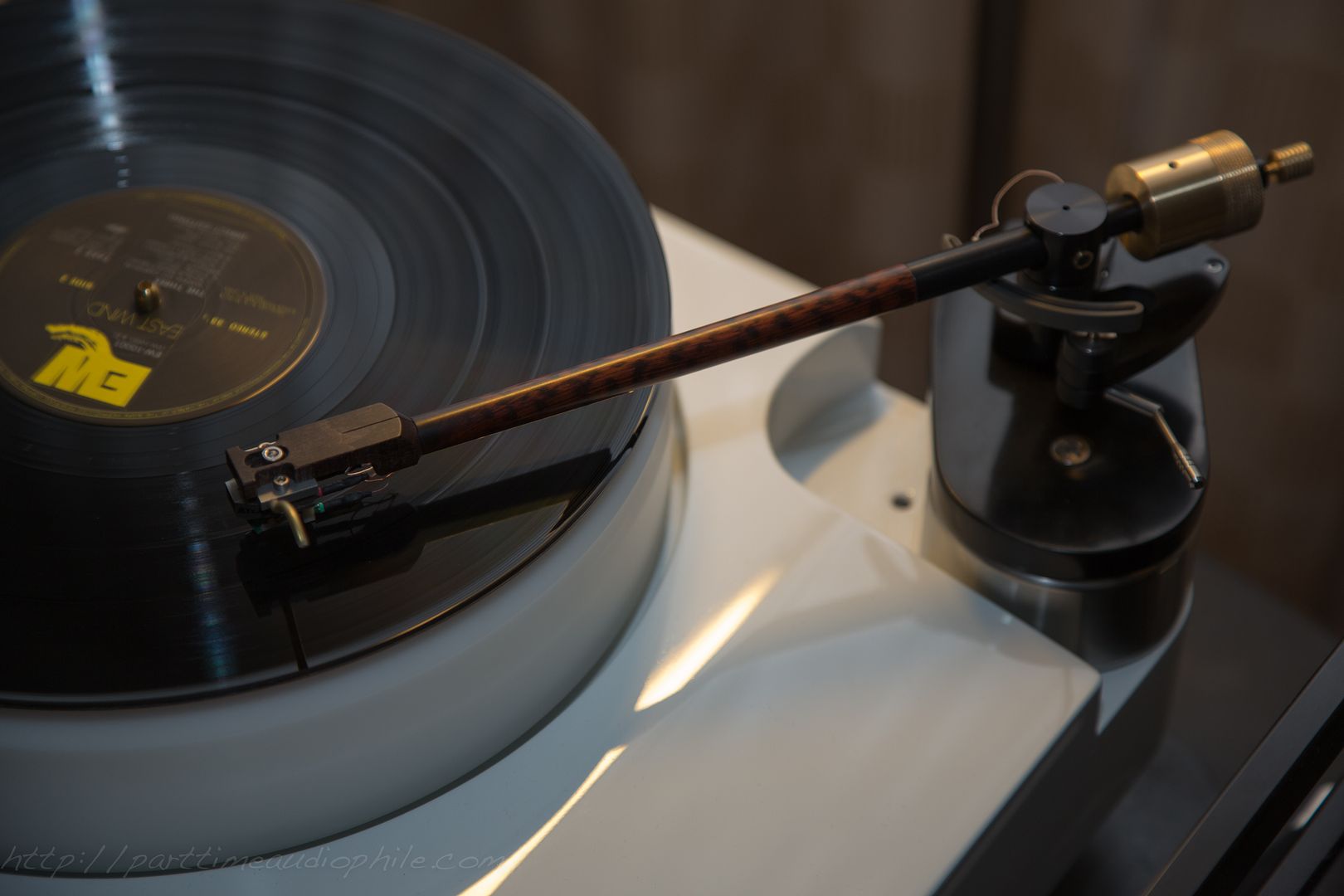
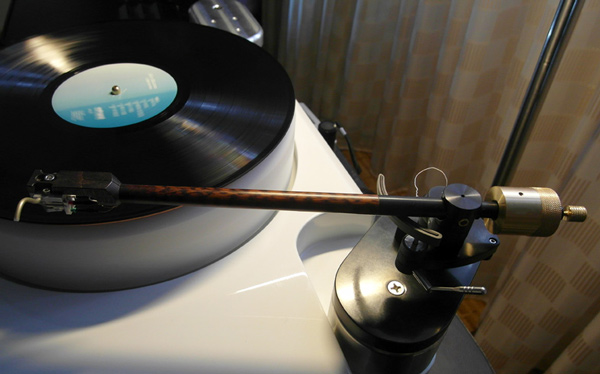

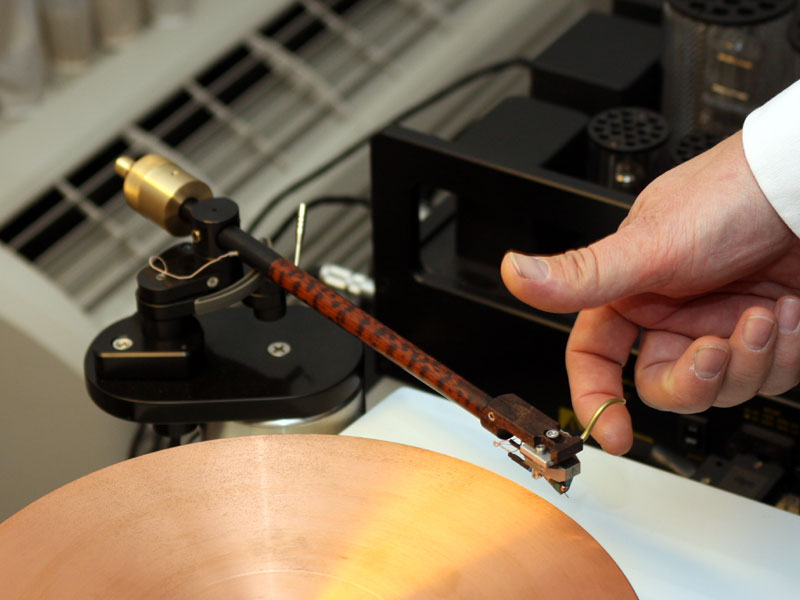
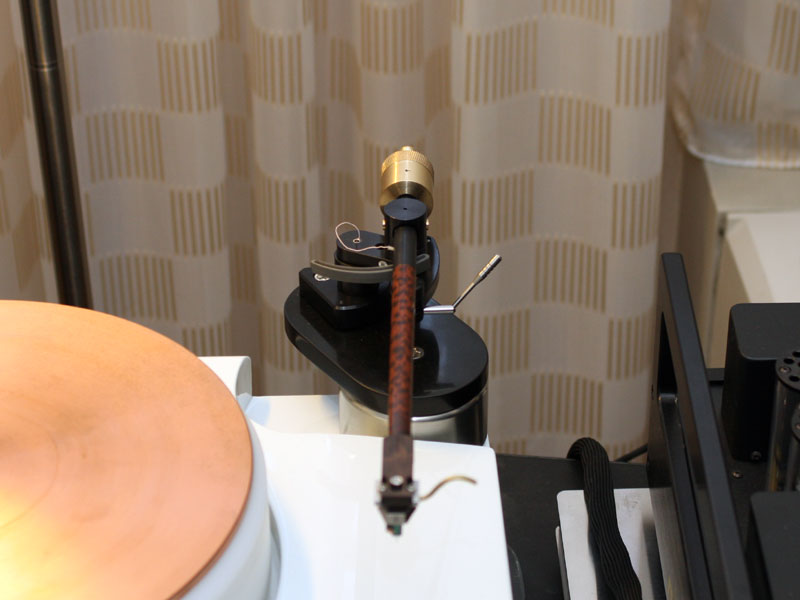
It's being imported to the USA and sold direct by Xact Audio and the introductry price is $8900.






An externally hosted image should be here but it was not working when we last tested it.
It's being imported to the USA and sold direct by Xact Audio and the introductry price is $8900.
An externally hosted image should be here but it was not working when we last tested it.
Last edited:
Never...Hi Christophe, Did you work for Rega too?
I don't even know witch one was the first on the market...
To be sincere, it is just a bad idea... Just a look for sale... Better to have your vinyls damped on all their surface.
It can help with some very deformed vinyls to find a middle between ups and downs, the only advantage i can see...
Frank Schröder interview for the 2012 RMAF:
What's new about the new Schröder tangentially tracking tonearm?
First of all, it does what all linear tracking tonearms try to achieve, namely holding the stylus assembly, not just the cartridge, in a position that equals that of the cutting stylus at all times/radii as it traces a record.
But where conventional linear tracking tonearms rely on either a servo mechanism to keep the error below a certain threshold or a passively driven, low to near zero friction bearing assembly, the new Schröder utilizes a patent pending mechanism that moves the foot point (base) of the tonearm as it traces the grooves such that perfect tangency is maintained at all times. No servo, no air pumps and hoses, no excessive effective mass in the horizontal plane.
You'll notice that the headshell doesn't feature an offset angle, indispensable for conventional pivoted arms to minimize tracing error related distortions. Here, the cartridge suspension will not be loaded asymmetrically as (when properly set up) there is no skating force for which to compensate, nor even an asymmetry in the mass distribution of the main arm.
The total displacement of the foot point is less than one third of the required equivalent for a conventional linear tracking tonearm. The forces required to move the entire arm are considerably smaller due to the proportionally greater leverage and the use of the finest bearing available. This accounts for a total bearing friction in the horizontal plane that is lower than 3.5mg.
The bearings for the vertical movement are zero friction/zero stiction designs, combining the virtues of an airbearing with the rigidity of a preloaded ball bearing.
All relevant parameters are adjustable, including VTA/SRA. I opted for a simple, yet mechanically sound shaft/collar arrangement. A preloaded set screw allows for changes without the risk of the arm "dropping". VTF is fine tunable via a small knurled weight screw behind the main counterweight. Azimuth can be adjusted within a range of +/- 3°
The effective mass falls into the medium to high category. Depending upon your choice of cartridge mounting plate (a proven concept taken over from previous Schröder tonearm designs), it ranges from 14 to 21gr.
The effective length of the main arm is 250mm, the pivot to spindle mounting distance 275mm due to the additional pivoting bar. Obviously, the overhang is Zero.
The armwands are handmade of either Snakewood or Grenadill, both treated extensively (a time and labor intensive process) to assure total immunity from changes in humidity or temperature.
The headshell is fabricated from a proprietary material that combines stiffness, low mass and high internal damping.
The cryogenically treated, high purity copper wiring runs uninterrupted from the cartridge clips to the RCAs Bullet plugs(XLRs available upon request).
What does all of this mean in terms of sound quality?
The new arm, which shall be labelled Schröder LT, for "linear tracking"(even though it isn't in the strictest sense of the word) omits many a flaw of existing arms, pivoted or linear tracking, by keeping all forces exerted on the cantilever assembly (other than those generated by the groove) to an unprecedented minimum. This results in a greater dynamic range, an extremely clean rendition of complex signals, rock solid images in space, neither blown up nor reduced to mere dots, but three-dimensional as captured by the recording engineer. Like all of my previous designs I value truthfulness of timbre very highly, so expect a total absence of "grain" or resonances that may add "excitement" but will ultimately lead to listening fatigue.
It was engineered and built simply to communicate emotion inherent in all types of great music, so listen for yourself...
An externally hosted image should be here but it was not working when we last tested it.
An externally hosted image should be here but it was not working when we last tested it.
Last edited:
"The cryogenically treated..."Frank Schröder interview for the 2012 RMAF:
Handcrafted by virgins...
Where one word can destroy the credibility of an entire page of arguments about friction forces.
Last edited:
Hi, Straight Tracker1- What does cryogenically treated copper wire have to do with frictional forces?
2-Where, in the interview, does it say anything about "handcrafted by virgins"?
1: He pretend that he have less frictional forces with a system using at least more than twice the ball bearings of a traditional arm.
That is as credible than talking about snake oil quality, oh, sorry, cryogenic snake oil.When he talked about cryogenic, i made my mind...
2- Where do -you see quotes in this personal comment ?
Just, i'm pissed off by all this make believe marketing fairy tales.
Last edited:
It's all about context. It's not hard to see the Schröder arm having less friction than mechanical arms in the horizontal movement. Pivot bearings in general have less friction than linear bearings. He didn't say "traditional arm." He meant "conventional linear tracking tonearms" as explained in the below quote:
The part about low friction is referring "vertical movement" of the arm and he did NOT claim it has less friction than traditional arm:
And finally, why so angry? I assume you visit this thread often enough is because you enjoy observing and discussing this topic. Take it easy, Christophe. Have a beer, or cryogenically treated beer! Or one made by virgins?
But where conventional linear tracking tonearms rely on either a servo mechanism to keep the error below a certain threshold or a passively driven, low to near zero friction bearing assembly, the new Schröder utilizes a patent pending mechanism that moves the foot point (base) of the tonearm as it traces the grooves such that perfect tangency is maintained at all times. No servo, no air pumps and hoses, no excessive effective mass in the horizontal plane.
The part about low friction is referring "vertical movement" of the arm and he did NOT claim it has less friction than traditional arm:
"The bearings for the vertical movement are zero friction/zero stiction designs, combining the virtues of an airbearing with the rigidity of a preloaded ball bearing."
And finally, why so angry? I assume you visit this thread often enough is because you enjoy observing and discussing this topic. Take it easy, Christophe. Have a beer, or cryogenically treated beer! Or one made by virgins?
I was not angry, it was a wink.And finally, why so angry?
And about vertical friction: "zero friction/zero stiction" WOW !
I don't want to speak for Frank and I'm sure he will explain this further when he comes back to this thread and has the time. But in the meantime, we should be excited to finally have a commercial product that's an alternative to the dominance of air-bearing and servo arms. It's the only tangential pivot arm next to the Thales arms in the market today. I wish to see more in the future and one that's affordable to me or other budget minded audiophiles.
Long live tangency!
Long live tangency!
- Home
- Source & Line
- Analogue Source
- Angling for 90° - tangential pivot tonearms
